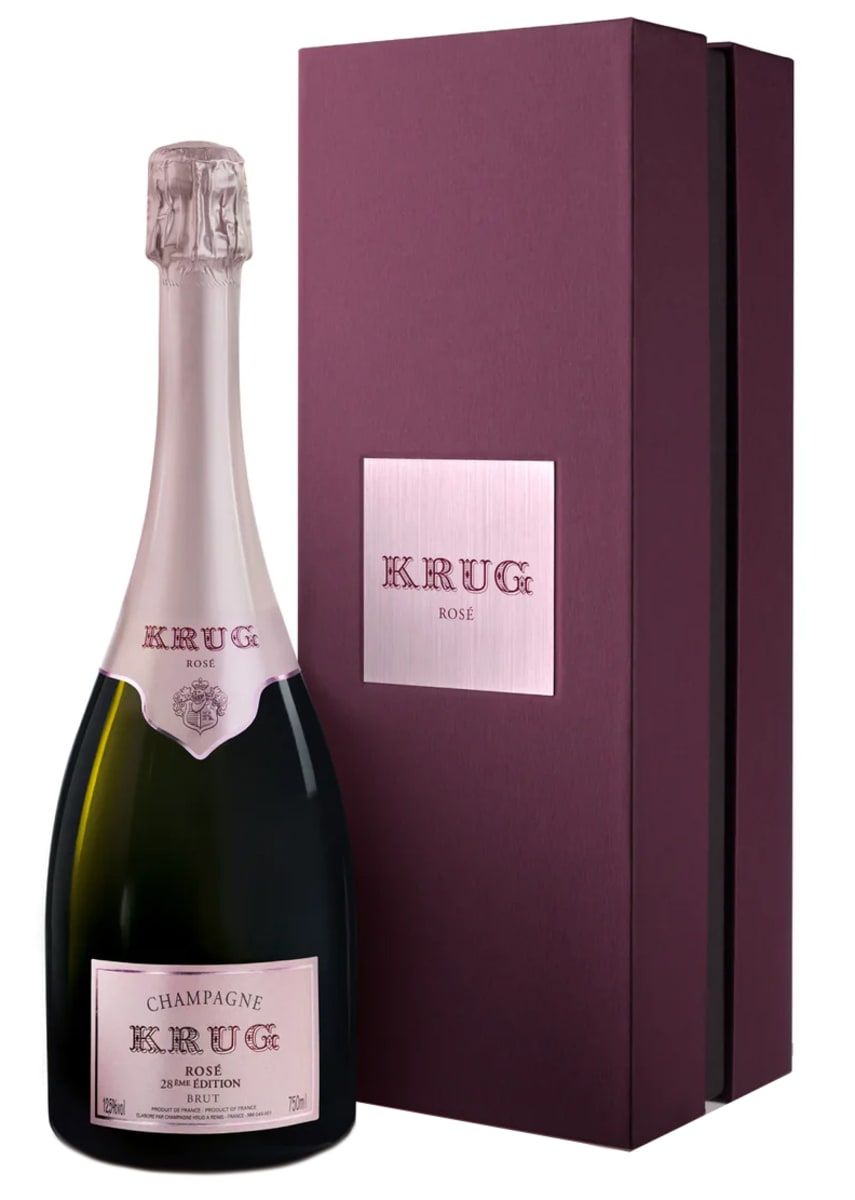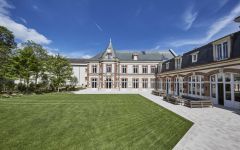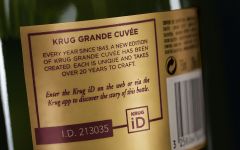Krug Brut Rose (28th Edition) with Gift Box
-
James
Suckling - Decanter
-
Wine
Spectator - Vinous




Product Details
Your Rating
Somm Note
Winemaker Notes
At first sight, its subtle pale pink color holds a promise of elegance. On the nose, aromas of rose hips, cured ham, mulberries, redcurrant, peony, pepper and pink grapefruit. On the palate, delicate flavors of honey, citrus and dried fruit with a long finish, enhanced by its fine bubbles complete the experience.
Krug Rosé lends itself to pairing ideas outside the box. For example, when it accompanies very good quality anchovies, a magical encounter occurs. The saltiness of the fish sublimes the fruit aromas and silkiness of the Champagne, turning the anchovies into a velvet sensation. Krug Rosé can also be enjoyed with foie gras, lamb, game, white meat, venison or even dishes with spices. Krug Rosé is not recommended for desserts, unless they are not sweet at all. Unexpectedly, it best accompanies very savory dishes.
Professional Ratings
-
James Suckling
Beautiful peach-pink color with a copper hue and a lot of floral nuances on the nose, offering dried cherries, peach skin and spices. It shows intensity and power, yet with elegance and precision. Full-bodied with a fine texture and phenolic tension. Bright and already delicious with some zesty, dried orange peel character at the end. Drink or hold.
-
Decanter
Already gorgeously aromatically expressive, playing notes of delicate raspberry leaf and rose petals alongside exoctic orange and grapefruit rind. There's an inherent freshness here, long cascading lines of acidity banked by uplifting minty notes. What a sexy wine, one that teases sweetness against bitter fruit skin, like biting voraciously into a plump succulent cherry and savouring its fleeting, electrifying impact. I love the toothsome, tasty fruit profile. The blend is 62% from the 2016 vintage, with 38% of reserve wines dating back to 2010, and 10% of Pinot Noir red wine, made up of 32 separately vinified wines from six different years.
-
Wine Spectator
A majestic rosé Champagne of impeccable balance, with remarkable depth of flavor and focus to its flavors of raspberry puree, kirsch and grilled nuts, plus hints of saffron, blood orange peel and ground coffee. The finely detailed mousse glides across the palate, enmeshed with chiseled acidity. The vibrant frame carries the profile on the long, long finish. Pinot Noir, Chardonnay and Pinot Meunier. Disgorged winter 2022 to 2023 (Krug ID 123009). Drink now through 2034.
-
Vinous
The NV Krug Rosé 28ème Édition is terrific. A rich, substantial Champagne, the Rosé possesses notable textural depth and substance. Hints of orange peel, cinnamon, dried rose petals and sweet red cherry fruit are all laced together in a creamy, beautifully resonant Champagne. Some previous editions have been more linear, but the 28ème feels richer, with a greater role given to the Pinot Noir, with important contributions from base wines from Mareuil-sur-Aÿ and Les Riceys. Time in the glass brings out gorgeous focus to pull it all together. Readers will find an extremely versatile Rosé that will provide immense pleasure, both on its own or at the dinner table. This release is based on 2016, with 38% reserve wines back to 2010, 58% Pinot Noir, 25% Chardonnay and 17% Meunier. Disgorged: Winter 2022-2023. Krug ID: 123009.









Krug has always lived up to its reputation as the first and only Champagne House to create exclusively prestige Champagnes every year since its foundation.
The House was established in Reims in 1843, by Joseph Krug, a visionary non-conformist with an uncompromising philosophy. Having understood that the true essence of Champagne is pleasure itself, his dream was to craft the very best Champagne he could offer, every single year, regardless of annual variations in climate. Paying close attention to the vineyard’s character, respecting the individuality of each plot and its wine, as well as building an extensive library of reserve wines from many different years allowed Joseph Krug to fulfil his dream.
With a very original approach to Champagne making, he decided to go beyond the notion of vintage to create the most generous expression of Champagne, every year. Thus, he founded a House in which all Champagnes are of the same level of distinction.
Six generations of the Krug family have perpetuated this dream, enriching the founder’s vision and savoir faire.
Further elaborating on the notion of individuality, for Krug’s Cellar Master Julie Cavil, each plot of grapes, through its wine, is like a single ingredient to a chef: carefully selected, and critical to the final composition. Each year, Krug honors this philosophy by inviting chefs from around the world to interpret a single ingredient, crafting unexpected recipes to pair with a glass of Krug Grande Cuvée or Krug Rosé. This year’s ingredient is the Onion.
The unspoken onion is a key component of almost every fundamental recipe from stocks, sauces and stews to baked goods and roasts. Its multifaceted expressions beautifully marry both the fullness of flavors and aromas of Krug Grande Cuvée the elegance and boldness of Krug Rose.

What are the different types of sparkling rosé wine?
Rosé sparkling wines like Champagne, Prosecco, Cava, and others make a fun and festive alternative to regular bubbles—but don’t snub these as not as important as their clear counterparts. Rosé Champagnes (i.e., those coming from the Champagne region of France) are made in the same basic way as regular Champagne, from the same grapes and the same region. Most other regions where sparkling wine is produced, and where red grape varieties also grow, also make a rosé version.
How is sparkling rosé wine made?
There are two main methods to make rosé sparkling wine. Typically, either white wine is blended with red wine to make a rosé base wine, or only red grapes are used but spend a short period of time on their skins (maceration) to make rosé colored juice before pressing and fermentation. In either case the base wine goes through a second fermentation (the one that makes the bubbles) through any of the various sparkling wine making methods.
What gives rosé Champagne and sparkling wine their color and bubbles?
The bubbles in sparkling wine are formed when the base wine undergoes a secondary fermentation, which traps carbon dioxide inside the bottle or fermentation vessel. During this stage, the yeast cells can absorb some of the wine’s color but for the most part, the pink hue remains.
How do you serve rosé sparkling wine?
Treat rosé sparkling wine as you would treat any Champagne, Prosecco, Cava, and other sparkling wine of comparable quality. For storing in any long-term sense, these should be kept at cellar temperature, about 55F. For serving, cool to about 40F to 50F. As for drinking, the best glasses have a stem and a flute or tulip shape to allow the bead (bubbles) and beautiful rosé hue to show.
How long do rosé Champagne and sparkling wine last?
Most rosé versions of Prosecco, Champagne, Cava or others around the “$20 and under” price point are intended for early consumption. Those made using the traditional method with extended cellar time before release (e.g., Champagne or Crémant) can typically improve with age. If you are unsure, definitely consult a wine professional for guidance.

Associated with luxury, celebration, and romance, the region, Champagne, is home to the world’s most prized sparkling wine. In order to bear the label, ‘Champagne’, a sparkling wine must originate from this northeastern region of France—called Champagne—and adhere to strict quality standards. Made up of the three towns Reims, Épernay, and Aÿ, it was here that the traditional method of sparkling wine production was both invented and perfected, birthing a winemaking technique as well as a flavor profile that is now emulated worldwide.
Well-drained, limestone and chalky soil defines much of the region, which lend a mineral component to its wines. Champagne’s cold, continental climate promotes ample acidity in its grapes but weather differences from year to year can create significant variation between vintages. While vintage Champagnes are produced in exceptional years, non-vintage cuvées are produced annually from a blend of several years in order to produce Champagnes that maintain a consistent house style.
With nearly negligible exceptions, . These can be blended together or bottled as individual varietal Champagnes, depending on the final style of wine desired. Chardonnay, the only white variety, contributes freshness, elegance, lively acidity and notes of citrus, orchard fruit and white flowers. Pinot Noir and its relative Pinot Meunier, provide the backbone to many blends, adding structure, body and supple red fruit flavors. Wines with a large proportion of Pinot Meunier will be ready to drink earlier, while Pinot Noir contributes to longevity. Whether it is white or rosé, most Champagne is made from a blend of red and white grapes—and uniquely, rosé is often produce by blending together red and white wine. A Champagne made exclusively from Chardonnay will be labeled as ‘blanc de blancs,’ while ones comprised of only red grapes are called ‘blanc de noirs.’
